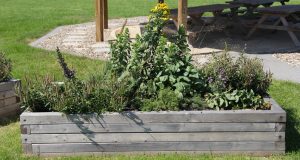Native plants get head start in cool fall weather
University of Illinois Extension Services — October 13, 2017
Some difficult to propagate plants are best if started in containers or boxes. The most effective time to plant a prairie from seed is in the fall as many prairie plants require a period of cold and moist weather to help germination. (Photo courtesy of IDNR)
Driving across Illinois in 2017, it can be difficult to imagine what the landscape looked like when Illinois was nicknamed the “Prairie State.”
With the plight of pollinators in the public mind, many are looking for ways to re-establish prairies as a habitat for pollinators, says University of Illinois Extension horticulture educator Alicia Gardner.
“The prairie is an ecosystem that can support a large diversity of plant, insect, bird, and other wildlife species,” Gardner says. “In general, for every prairie plant species, there are 10 insect species that depend on it for survival.”
Establishing a prairie, whether it be on 100 square feet or several acres of land, requires good planning and patience. It can take several years for the perennial flowers and grasses to germinate, develop long underground roots, and finally become visible above ground.
According to Gardner, diversity and site suitability are the two most important characteristics to consider when selecting plant species to include in your prairie.
“Your goal is to get a diversity of flowering plants to provide continuous blooms throughout the growing season, and a variety of grasses and sedges that create nesting sites and larval food supplies for pollinators,” she says.
Your source for native plants should be as local as possible in order to grow the most well-adapted plants for your area. The Illinois Department of Natural Resources (IDNR) and the US Department of Agriculture’s Natural Resource Conservation Service (USDA NRCS) provide a number of useful resources for identifying prairie plants that are native to your area, as well as tips and procedures for managing prairie habitats.
“Seeding is the most economical method for establishing a prairie, especially for larger sites,” Gardner notes. “Plant plugs and potted plants are substantially more expensive to purchase and require more labor to install. However, in small areas or for plant species that are difficult to propagate by seed, plugs or potted plants can provide more rapid establishment.”
The most effective time to plant a prairie from seed is in the fall; many prairie species require a period of cold and moist weather before their seeds will germinate. Site preparation prior to planting is critical in order to achieve success.
“During the summer before planting, you will need to kill out the current vegetation. Depending on the size of the site, a combination of tillage, herbicide application, and solarization are used to kill at least two flushes of weeds,” Gardner says.
After the preparation of the seedbed, plant your seed mix by broadcasting and rolling with a lawn roller in late fall (October – December). Avoid planting too early, when temperatures are warm enough to allow some seeds to germinate.
During the first two growing seasons after planting, mow the site at 8-10 inches high to control seed production in annual weeds. In the third year, you should begin to see many of your prairie species growing.
“At this stage, you will enter into a long-term management rotation,” Gardner says. “Some of the management strategies that are applied include mowing, prescribed burning, and grazing. You should never apply management to the entire plot in a single year; this allows the insects and other wildlife to take refuge in the unmanaged portion of the plot and repopulate the area after management.”
For more information about how to establish and maintain a prairie, contact your local Extension office. Don’t have a lot of space but still want to help the pollinators? Visit http://web.extension.illinois.edu/cfiv/pollinators/ to learn about small “Pollinator Pocket” gardens.
— Native plants get head start in cool fall weather —-



